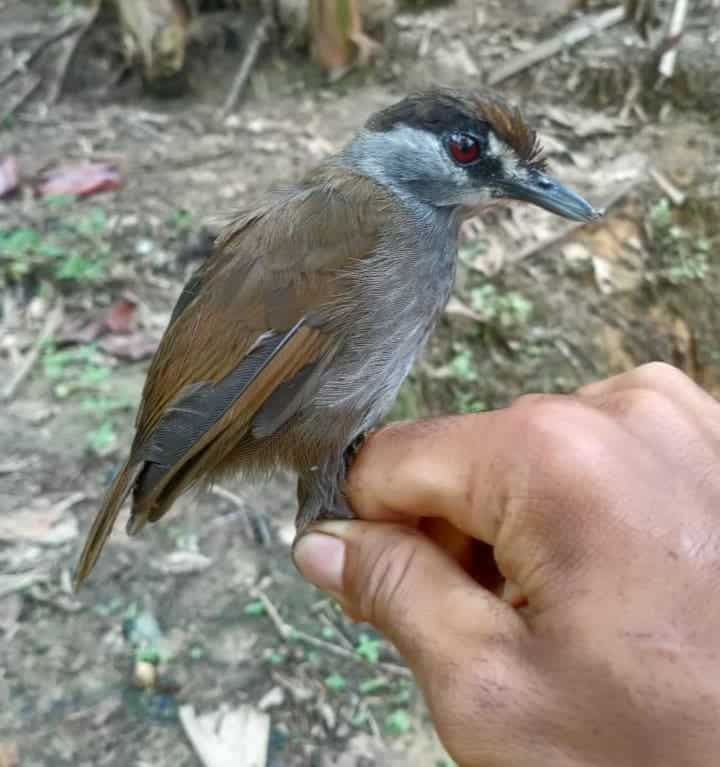It’s a good day to like birds, as locals in Kalimantan, Borneo, Indonesia, have rediscovered a bird thought to be extinct for almost two centuries.
The bird in question is the black-browed babbler, and we’ve only ever had sparse information on it. The western world was first treated to specimens and a description of this bird around 1848. Attempts to find the birds since have all failed, leaving us with very little data about the species’ traits including ecology, population, and behavior.
Needless to say, we assumed it went extinct. But we were wrong!
Birdspotting
“It was a bit like a ‘Eureka!’ moment,” said Gusti Akbar, of the Indonesian bird conservation group Birdpacker and lead author of the paper describing the finding.
“This bird is often called ‘the biggest enigma in Indonesian ornithology.’ It’s mind-blowing to think that it’s not extinct and it’s still living in these lowland forests, but it’s also a little scary because we don’t know if the birds are safe or how much longer they may survive.”
Muhammad Suranto and Muhammad Rizky Fauzan rediscovered the birds in October 2020 during a weekly trip to forage in the forests of the Southern Kalimantan Province, Borneo. As luck would have it, they accidentally captured a bird that neither recognized, took a few pictures of it, and let it fly loose. When they got home, they sent the pictures to the local birdwatching group BW Galeatus hoping someone there could identify it.
The group suspected it may have been a member of the long-lost species and contacted the ornithologists that penned the report. They compared the photos to a field guide description and photos of the only known black-browed babbler specimen at the Naturalis Biodiversity Center in the Netherlands.
Even from these few pictures, we’ve already learned something new about the black-browed babbler. For example, we now have a better understanding of its plumage, as several areas on birds‘ feathers lose tint during the taxidermy process meant to preserve them.
There’s still much more to learn, such as where, exactly, the babbler lives. Researchers first attributed its origin to the island of Java, which was later disputed based on the records kept by Carl A.L.M. Schwaner, the naturalist who retrieved the original specimen. It was estimated that the species makes home near the city of Martapura or Banjarmasin in Borneo, but this has not been confirmed up to now. The question now is how to best study this species when researchers are stuck at home or prevented from travelling overseas due to the pandemic.
“I think it is amazing that we managed to document one of the most remarkable zoological discoveries in Indonesia, largely through online communication, in the midst of the pandemic, which has hampered us from visiting the site,” said Teguh Willy Nugroho, who works in Sebangau National Park in Kalimantan and is one of the coauthors on the paper.
“When the species was first discovered, now-extinct birds like the great auk and passenger pigeon were still alive,” said Yong, a co-author on the paper and a Singapore-based conservationist with BirdLife International. “There is now a critical window of opportunity for conservationists to secure these forests to protect the babbler and other species.”
The babbler is currently listed as data deficient on the International Union of Conservation of Nature’s Red List of Threatened Species, and the team plans to eventually travel to Borneo to set this right by interviewing locals, determining the specie’s range, and total population. Such data should help us determine the conservation status of the bird much more reliably.
John C. Mittermeier, director of threatened species outreach at the American Bird Conservancy (ABC), commented on the finding explaining that “there are more than 150 species of birds around the world that are currently ‘lost’ with no confirmed observations in the past 10 years”, and that the ABC hopes this re-discovery sparks public interest in finding other rare or lost bird species around the world.
The paper “Missing for 170 years—the rediscovery of Black-browed Babbler Malacocincla perspicillata on Borneo” has been published in the journal BirdingASIA.










